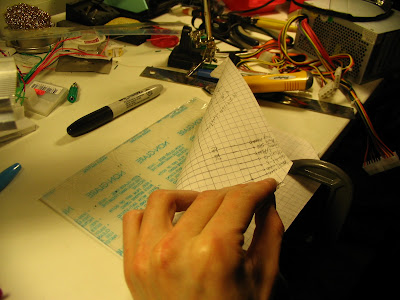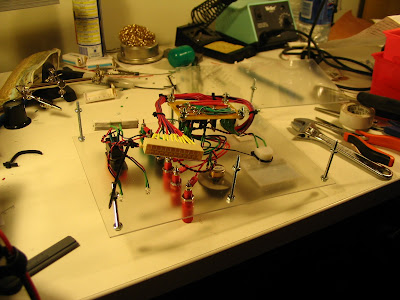In 2010 I got tired of continuously having to wire up breadboard power supplies. I found I often wanted to just prototype something quickly with a few parts I had lying around, but I frequently gave up before starting because I was too lazy to fish out and wire up yet another LM317 or something. Thus, as is the fashion when nothing too serious is required for a benchtop power supply, I put together a small ATX power supply breakout box with an adjustable voltage regulator.
I began by planning out a simple circuit. I put a voltmeter on the adjustable voltage branch as well as an ammeter on the common ground:
 |
| Circuit for the ATX power supply breakout box. |
I laid out the faceplate elements on cardboard to make sure things fit as intended:
 |
| Mocking up stuff on leftover cardboard. |
 |
| Cutting the cardboard to the correct dimensions. |
 |
| Final mockup. |
Then, I carefully transferred the markings to some acrylic sheets I had scored and snapped to size:
 |
| Transferring the layout markings from graph paper to acrylic faceplate. |
 |
| Making sure things line up. |
Then, I drilled all the required holes and openings on a drill press borrowed from my dad. I believe I used a sheet metal nibbler to square out the edges of the doorway-shaped holes, for the meters.
 |
| The cutouts. (This picture was actually taken after I removed the protective film, later on.) |
 |
| Cutouts. |
Then, I test-fit everything to make sure things would line up properly, that there was enough space, etc.:
 |
| Testing for fit. |
 |
| Will it close properly? |
 |
| Faceplate will look OK it seems. |
Since the test fit looked promising, I went ahead, peeled the protective film from the acrylic and assembled everything:
 |
| Wiring up the faceplate. |
 |
| More faceplate action. |
 |
| Adding the actual guts of the breakout box. |
And it turned out great:
 |
| Looks good. |
 |
| From up high. |
 |
| From the side |
 |
| Underside. |
 |
| Off. |
 |
| ATX supply on in standby, not delivering power yet. (That's the red LED.) |
 |
| Final result, delivering power as indicated by the green LED. In case of panic just slam the safety cover shut. |
In the end, everything works great except the ammeter. That was a dumb mistake; I didn't test it in-circuit before putting everything in place, and I didn't realise that it required special wiring. (I never looked into it but I suspect it actually acts as a voltmeter, and you have to wire it up across a specified value of resistor for it to work properly.)
After making use of this thing for a couple of years, I might say a couple of things about the design:
- Though I didn't think the zipties around the back would be sufficient to hold the meters in place, they are still there in 2012 and the meters haven't moved.
- On the other hand, it was hard to find an inspired way to hold the molex breakout in place; it sucked on day one and it still does today. (As you might be able to tell from the pictures I built a sort of acrylic clamp. Won't do that again, the connector keeps slipping out, the acrylic bends, etc.)
- Instead of using three nuts per screw, I now use standoffs I cut myself from 1/4" plastic water piping.
- The safety cover on the switch came in handy many times. Because it's spring-loaded, it's much easier to slam the thing shut than to flick a pretty rigid toggle switch.
- Acrylic is too fragile a material for something that will be manhandled like this; though it hasn't happened yet, I'm always afraid I'm going to break the thing.





















No comments:
Post a Comment